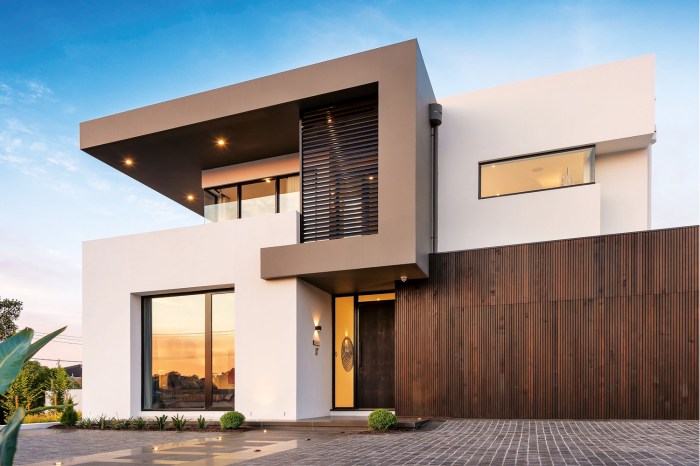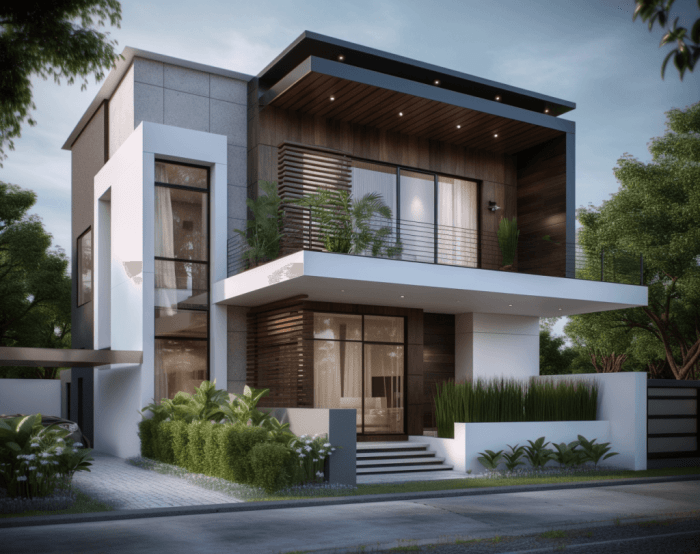Exploring Modern House Design: A Comprehensive Guide
Modern house design sets the stage for this enthralling narrative, offering readers a glimpse into a story that is rich in detail and brimming with originality. From the evolution of modern architecture to the integration of technology in interiors, this guide covers it all.
As we delve deeper into the key elements and concepts of modern house design, readers will gain a deeper understanding of what makes these homes truly unique and captivating.
Overview of Modern House Design

Modern house design refers to a style of architecture that emerged in the early 20th century, characterized by clean lines, open floor plans, and a focus on function over form. Key characteristics of modern house design include minimalism, use of natural materials, and large windows to bring in natural light.
Evolution of Modern House Design
Modern house design has evolved over the years, with influences from various architectural movements such as Bauhaus, International Style, and Mid-Century Modern. These influences have shaped the way modern houses are designed today, blending form and function to create spaces that are both aesthetically pleasing and practical.
Influence of Modern Architecture on Contemporary House Designs
- Integration of indoor and outdoor spaces: Modern house design often incorporates features like outdoor patios, decks, and courtyards to blur the lines between indoor and outdoor living.
- Use of sustainable materials: Contemporary house designs draw inspiration from modern architecture by prioritizing the use of eco-friendly and sustainable materials in construction.
- Emphasis on energy efficiency: Modern architecture has influenced contemporary house designs to focus on energy-efficient features like solar panels, passive heating and cooling systems, and high-performance windows.
- Minimalist aesthetic: The minimalist aesthetic of modern house design continues to influence contemporary architecture, with clean lines, simple forms, and uncluttered spaces being key design elements.
Elements of Modern House Design
Modern house design is characterized by a few key elements that set it apart from traditional styles. These elements focus on creating a sleek, minimalist aesthetic that emphasizes simplicity and functionality. Let's delve into the specific aspects that define modern house design.
Clean Lines and Geometric Shapes
In modern house design, clean lines and geometric shapes play a crucial role in creating a sense of order and sophistication. Straight lines and angular forms are commonly used in architectural elements such as windows, doors, and facades. These elements help to establish a sense of balance and harmony within the overall design of the house.
Materials Used in Modern House Construction
Modern houses often feature a combination of materials that reflect a contemporary aesthetic. Common materials used in modern house construction include concrete, glass, steel, and wood. These materials are chosen for their durability, sustainability, and ability to create a sleek and minimalist look.
The use of these materials also contributes to the overall energy efficiency of the house.
Natural Light and Open Floor Plans
One of the defining features of modern house design is the emphasis on natural light and open spaces. Large windows, skylights, and glass doors are strategically incorporated into the design to maximize the influx of natural light. This not only creates a bright and airy atmosphere but also helps to reduce the need for artificial lighting during the day.
Open floor plans further enhance the sense of spaciousness and connectivity within the living spaces, allowing for a seamless flow between rooms.
Interior Design in Modern Houses
When it comes to modern house design, interior design plays a crucial role in creating a sleek and functional living space. Modern interior design focuses on minimalism, technology integration, and sustainability to enhance the overall aesthetic and functionality of a home.
Minimalist Interior Design Concepts
Minimalist interior design in modern homes emphasizes simplicity, clean lines, and a clutter-free environment. This design approach focuses on using minimal furniture and decor to create a sense of openness and airiness in the space. Neutral color palettes, sleek surfaces, and strategic lighting are key elements in achieving a minimalist interior design in modern houses.
Integration of Technology and Smart Home Features
Modern house interiors often incorporate technology and smart home features to enhance convenience and efficiency. This includes home automation systems, smart lighting, thermostats, and security systems that can be controlled remotely via smartphones or voice commands. Integrating technology seamlessly into the design allows for a more connected and futuristic living experience.
Use of Sustainable and Eco-Friendly Materials
Sustainability is a growing trend in modern interior design, with a focus on using eco-friendly materials and practices to reduce environmental impact. In modern houses, sustainable materials such as bamboo flooring, reclaimed wood, recycled glass, and low-VOC paints are commonly used to create a healthier and more environmentally friendly living space.
By incorporating sustainable elements into the design, modern homes can promote a greener lifestyle and contribute to a more sustainable future.
Landscaping and Outdoor Spaces in Modern House Design

In modern house design, landscaping and outdoor spaces play a crucial role in enhancing the overall aesthetic and functionality of the property. By seamlessly blending indoor and outdoor areas, contemporary homes achieve a harmonious connection with nature while creating versatile living spaces for residents to enjoy.
Principles of Modern Landscaping for Contemporary Homes
Modern landscaping for contemporary homes focuses on clean lines, minimalistic design, and sustainable practices. Key principles include:
- Use of native plants and drought-resistant vegetation to promote biodiversity and reduce water consumption.
- Incorporation of hardscaping elements such as stone pathways, concrete patios, and wooden decks for a cohesive outdoor design.
- Integration of eco-friendly features like rain gardens, green roofs, and permeable paving to manage stormwater and improve sustainability.
Significance of Outdoor Living Spaces in Modern House Design
Outdoor living spaces are essential in modern house design as they provide residents with opportunities to connect with nature, relax, and entertain guests. The significance of outdoor spaces includes:
- Extension of living areas beyond the confines of the house, creating a seamless transition between indoor and outdoor environments.
- Promotion of health and well-being by encouraging outdoor activities, social gatherings, and relaxation in natural surroundings.
- Enhancement of property value and curb appeal through thoughtfully designed outdoor spaces that complement the architectural style of the home.
Use of Sustainable Practices in Modern House Landscaping
Sustainable practices are increasingly being incorporated into modern house landscaping to minimize environmental impact and promote long-term sustainability. Examples of sustainable practices include:
- Installation of energy-efficient outdoor lighting using LED technology to reduce electricity consumption and light pollution.
- Implementation of smart irrigation systems that adjust water usage based on weather conditions and plant needs, conserving water resources.
- Creation of wildlife-friendly habitats with features like bird feeders, pollinator gardens, and bat houses to support local biodiversity and ecosystem health.
Closing Summary
In conclusion, modern house design encapsulates a harmonious blend of functionality, aesthetics, and sustainability. From clean lines to sustainable practices, these homes represent the epitome of contemporary living. Dive into the world of modern house design and unlock a realm of endless possibilities for your dream home.
Quick FAQs
What are the key characteristics of modern house design?
Modern house design often features clean lines, open floor plans, and an emphasis on natural light. Sustainability and eco-friendly materials are also common elements in modern homes.
How has modern house design evolved over the years?
Modern house design has evolved to embrace new technologies, sustainable practices, and innovative materials. The focus has shifted towards creating efficient, functional, and aesthetically pleasing living spaces.
What are some common materials used in modern house construction?
Common materials used in modern house construction include glass, steel, concrete, and wood. These materials are chosen for their durability, sustainability, and modern aesthetic appeal.
Why is natural light important in modern homes?
Natural light helps create a sense of openness, enhances the overall ambiance of a space, and reduces the need for artificial lighting. It also promotes a connection to the outdoors and can improve mood and well-being.




